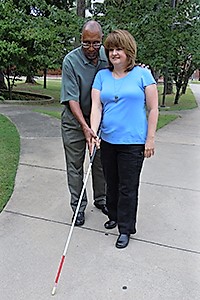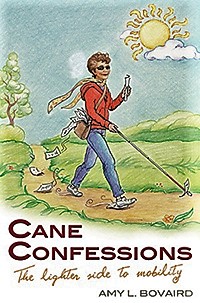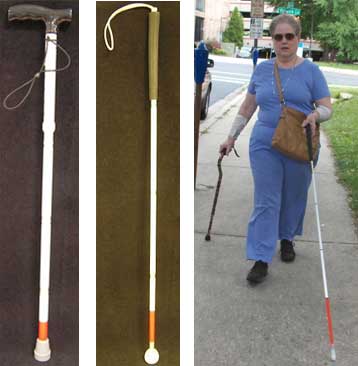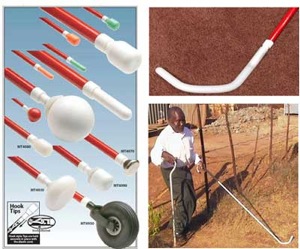What is Orientation and Mobility?
This content is also available in:
Español (Spanish)
What is Orientation and Mobility?
 Learning to use the white
Learning to use the white
cane with an O&M instructor
Orientation and Mobility (O&M) is a profession specific to blindness and low vision that teaches safe, efficient, and effective travel skills to people of all ages:
- “Orientation” refers to knowing where you are and where you want to go, whether you’re moving from one room to another or walking downtown for a shopping trip.
- “Mobility” refers to the ability to move safely, efficiently, and effectively from one place to another, such as walking without tripping or falling, crossing streets, and using public transportation.
Orientation and Mobility Specialists
An Orientation and Mobility (O&M) Specialist provides instruction to help you develop or re-learn the skills and concepts needed to travel safely and independently within your home and the community. O&M Specialists provide services across the lifespan, teaching infants and children in pre-school and school programs and adults in various community-based and rehabilitation settings.
The Academy for Certification of Vision Rehabilitation and Education Professionals (ACVREP) offers certification for vision rehabilitation professionals, including O&M Specialists. A Certified Orientation and Mobility Specialist (COMS) must adhere to a professional Code of Ethics and demonstrate knowledge and teaching skills in the following areas:
- Sensory development, or maximizing all of your senses to help you know where you are and where you want to go
- Using your senses in combination with self-protective techniques and human guide techniques to move safely through indoor and outdoor environments
- Using a cane and other devices to walk safely and efficiently
- Soliciting and/or declining assistance
- Finding destinations with strategies that include following directions and using landmarks and compass directions
- Techniques for crossing streets, such as analyzing and identifying intersections and traffic patterns
- Problem-solving skills to determine what to do if you are disoriented or lost or need to change your route
- Using public transportation and transit systems.
Amy Bovaird, Author of Mobility Matters: Stepping Out in Faith and Cane Confessions: The Lighter Side to Mobility

Amy Bovaird is a VisionAware Peer Advisor and author of Mobility Matters: Stepping Out in Faith and Cane Confessions: The Lighter Side to Mobility, her compelling memoirs that recount her life as an international teacher and traveler, her diagnosis of retinitis pigmentosa, and her triumph at learning to travel independently once again, using her long white cane.
Says Amy, “Mobility matters. It allows me to join the rest of society, follow my interests and passions, and reconnect with my love for traveling. I don’t have to stay at home fearing the dark anymore. I can live independently.”Learn more about ways to find emotional support for you – and your family members – after an eye condition diagnosis:
Orientation and Mobility Instruction
O&M instruction is usually conducted on a one-to-one basis. It can take place either in the community where you live and/or work (called “itinerant O&M”) or at a rehabilitation center (called “center-based O&M”).
To locate an Orientation and Mobility Specialist in your home area, our Directory of Services includes information about Orientation and Mobility instruction.
The Different Types of Canes
Two types of canes are most commonly used:
- The support cane provides physical stability. A white support cane can identify you as a person who is blind or has low vision.
- The probing cane (more commonly called a “white cane” or a “long cane”) probes for and locates obstacles in your path of travel.

Left: One type of support cane (credit: Wikipedia)
Middle: One type of “probing” cane (credit: Wikipedia)
Right: Using a support cane and a probing cane for
outdoor travel (credit: Dona Sauerburger)
Long white canes come in two categories: folding canes and straight-style. Folding canes, which can be collapsed and stored easily, come in aluminum or graphite models. Graphite canes are lighter and easier to fold and unfold than aluminum ones. While great for travel, folding canes tend to be less sturdy when compared to straight (non-folding) canes and don’t provide the same amount of sensory feedback.
A popular straight-style cane is made of fiberglass, which is ultra-light, provides lots of sensory feedback, and bends slightly if it slides under a car or similar obstacle.
A Support Cane Should:
- Be strong enough to support your weight. This usually means that a support cane is not lightweight.
- Be short enough to rest your hand on top while you hold it close to your body.
- Have a tip that grips the floor and does not slide.
A Probing Cane (“White Cane” or “Long Cane”) Should:
- Be lightweight to hold and move it in front of you without becoming tired.
- Be long enough to reach ahead and warn you about obstacles and stairs.
- Have a tip that can slide easily along the ground.
A support cane and a probing cane are designed differently and serve very different purposes, so the choice of which cane to use will depend on your needs:
If you need a cane to help you know what is on the ground in front of you, it is recommended that you use a probing cane.
- Please note: If you use a support cane to probe the ground ahead, it is usually impossible to reach far enough ahead without leaning forward. This harms your posture and appearance and is risky, particularly when approaching descending stairs. If you miss your footing or lose your balance while leaning forward, you will likely fall forward and tumble down the stairs.
You will need two canes if you can’t see well enough to know what is on the ground in front of you and need a cane for support.
- One cane will provide the support you need, and the other will probe ahead to scan for obstacles, stairs, and curbs.
- It may seem awkward and difficult to use two canes, but with effective orientation and mobility (O&M) instruction, people of all ages have learned to use two canes correctly and safely.
Cane Tips
A wide variety of cane tips now provide smoother operation and more durability. Each tip has its pros and cons.
- Pencil tip. Pros: Good feedback and lightness make it a good choice for people who have problems moving their wrist for long periods of time. Cons: The long, thin tip tends to get stuck in cracks in the sidewalk.
- Roller tip. Pros: Rolls over cracks in the sidewalk, making for a smoother walk. Cons: Greater weight can add to wrist fatigue; it doesn’t give the traveler as much feedback about small terrain changes.
- Marshmallow tip. Pros: The thick tip won’t get stuck in cracks easily. Cons: The tip is heavy and can cause wrist fatigue over time.
- Metal glide. Pros: Very light; glides easily over cracks.
- Cane tips have been developed for travel in wilderness areas and farms, such as the “Bundu Basher.” For more information about the Bundu Basher cane tip, including photographs, explanations, and ordering information, see Bundu Basher.

Left: Cane tips from AmbuTech are now available in
a wide variety of styles and functions (credit: AmbuTech)
Right Top: The “Bundu Basher” cane tip for wilderness
travel (credit: Dona Sauerburger)
Right Bottom: Rural travel with the “Bundu Basher” cane
tip and a support cane (credit: Moira Higgerty)
Can I use a cane if I also use a wheelchair?
You can use a wheelchair and learn how to use a long cane to help navigate obstacles and drop-offs. However, success depends on individual circumstances, such as your type and level of vision, overall physical limitations, and chair style. Consult your O&M specialist about whether using a long cane with a wheelchair is right for you.
Alternative mobility devices (AMDs)
Alternative mobility devices have been developed that provide full protection for people who cannot use the cane reliably or move it correctly, either because of physical limitations (including difficulty or pain when moving the wrist) or cognitive disabilities.